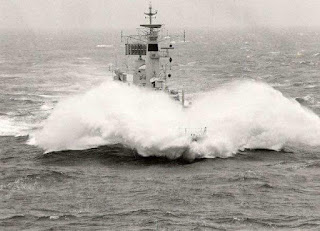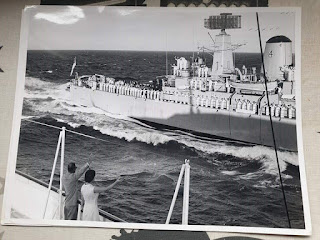We had just left Brazil after escorting the Royal Yatch with the Queen and Prince Philip aboard on a state visit to Recife, Salvador and Rio in Brazil.
We had previously left Portsmouth and visited Gibraltar, Madeira, Cape Verde, and The Salvage islands and shortly after we met up with HMS Danae and the Royal Yatch.
This was part of an almost yearlong deployment in which we carried out several patrols and visits in the Gulf, Indian Ocean and the Pacific Ocean.
This particular journey relates to our transit in the southern Ocean where we stopped off at Tristan da Cunha en route to South Africa. Tristan is a remote volcanic island in the South Atlantic. We stopped off there to deliver essential supplies and mail and help with some repairs that they had suffered from a recent storm.
My favourite duty when on watch at sea was lookout, where I was positioned on the bridge with a pair of binoculars scanning for ships, aircraft etc. but personally for birds and any other life that was present on the ocean.
The sea life in that area of the ocean was rich in variety and unfortunately we could not identify a lot as the only reference we had was “A guide to Seabirds of the Ocean routes” by Gerald Tuck which I acquired from the ships library. There was also a couple of crew members with the same interest and we were members of the “Royal Navy Birdwatching Society”.
However we did manage to identify some species and some down to family or genus.
As we left Rio I looked back at the “Christ the Redeemer” statue that stand proud on Corcovado Mountain but what grabbed my attention was a small flock of Magnificent Frigatebird wheeling over the harbour.
As we proceeded east we started seeing a number of seabirds with a lot of species unidentified. We also saw a few Penguin that were identified as Magellanic Penguin. Also identified were Cape Petrel, White-faced Petrel, Wilson’s Petrel, Sooty Tern, Brown, Masked and Red-footed Booby, Great and Lesser Frigatebird and both Red-billed and White-tailed Tropicbird and several Gull and Tern species.
We refuelled and took on provisions at sea with the Royal Fleet Auxiliary “Wave Chief” and then steamed on for Tristan.
The first Albatross seen was approx. halfway to Tristan and was a Wandering Albatross. This bird followed us for a few days and was seen regularly hanging in the air off the stern of the ship using the drag of the ship to propel it along.
A few more Albatross species were seen with a few coming close enough to be identified. These were Atlantic Yellow-nosed Albatross and Grey-headed Albatross.
As we neared Tristan seabird numbers increased, we anchored off the island and used the on-board helicopter and sea boats to get some of the crew ashore to assist the islanders.
As we were stood down from sea duties we had more leisure time to observe the sea life which include Tristan Albatross, Northern Rockhopper Penguin, Great Shearwater and Sooty Shearwater at close quarters.
One bird that we all wanted to see that was not a seabird was the Tristan Thrush, an endemic to the island and found nowhere else in the world and during a brief visit ashore we managed to find 2 individuals.
Other species seen during our 6 day stay were: Brown Noddy, Northern Giant Petrel, Common Diving Petrel, Black-browed Albatross, Brown Skua/Sub-Antarctic Skua, Southern Fulmar, several other Petrel species and more Shearwater species.
We left Tristan heading for South Africa and picked up another follower. Another Wandering Albatross that again followed for several days.
More Albatross were noted and 2 new species seen. Light-mantled Albatross and Sooty Albatross. These are more southerly species and some of my favourites.
As we neared the African coast again seabird species increased with several Tern and Gull species, African Penguin, Cape Petrel, Cape Gannet and more Petrel and Albatross species.
As well as the birds we saw many mammals and fish. My first Blue Whale, several Dolphin and larger Whale species, 2 Elephant Seal species, Sub-Antarctic Fur Seal, Cape Fur Seal, Sharks, Marlin, Barracuda, Swordfish, Flying Fish, Manta Rays and the list goes on.
Some of my notes from back then have either disintegrated or got lost but I managed to get some information from some old documents and a few contacts from back then. The wildlife journey did not end there as we continued our deployment along the East African coast to the Gulf, to India, the Far East and Japan. That’s a story for another day.
No wildlife photos from back then unfortunately only Navy stuff.







